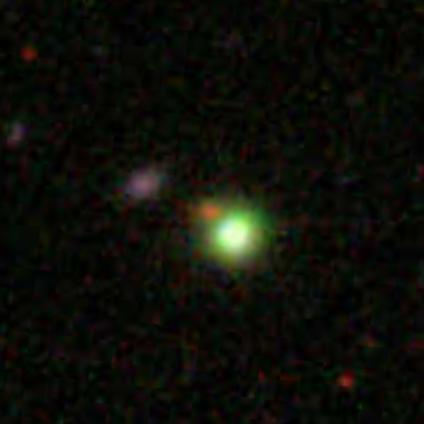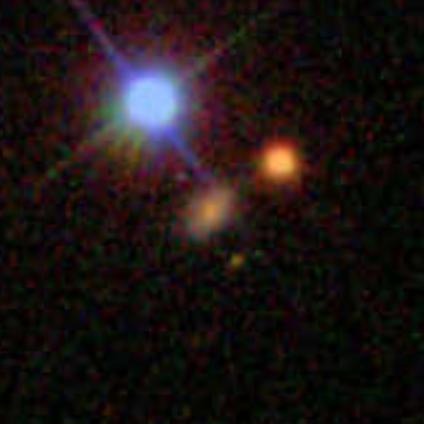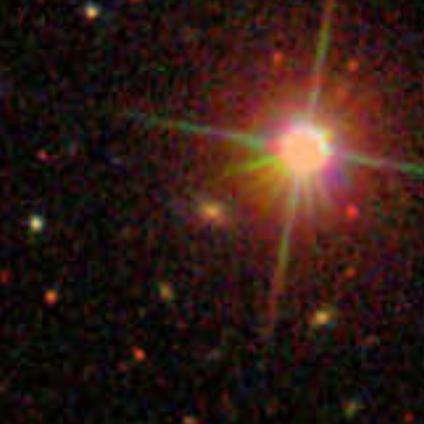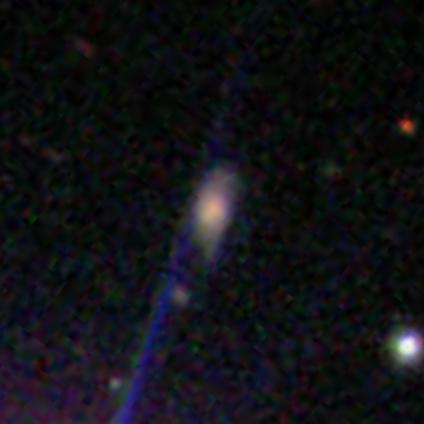Outliers - collect them here!
-
 by
JeanTate
by
JeanTate
The analysis we'll be doing in Stage 2 will include identification of "outliers", and decisions on what to do about them.
For example, AGS00002ak (DR7 ObjId 758877274402460510) is not even a galaxy, and AGS000022s (587741726574444657) has a 'bad spectrum' (a big chunk of it is blank)1.
We may decide to keep some of the outliers, for at least part of the analyses; however, I think it would be useful/helpful to have all identified outliers in one place, along with a description of what makes them suspect.
1see this thread for some details.
Posted
-
 by
JeanTate
by
JeanTate
AGS00001w5 (DR7 ObjId 587739828214759654): two halves of the spectrum not properly joined together (more here).
Posted
-
 by
JeanTate
by
JeanTate
AGS00001dn (587733432461754555): foreground (our own galaxy) star overlapping the nucleus/bulge of the target galaxy (more here).
Posted
-
 by
JeanTate
by
JeanTate
AGS00004d5 (587745447095304755, DR7 specObjId 809756457913286656): star
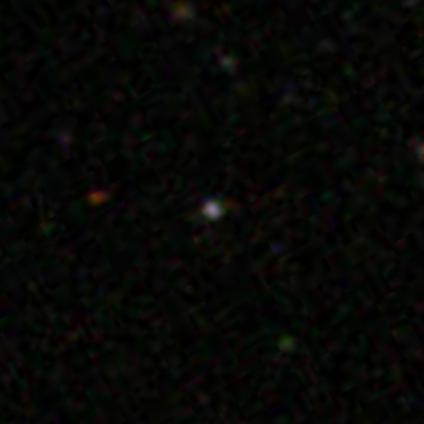
Posted
-
 by
JeanTate
by
JeanTate
AGS00002y7 (587732152572313657): HII/star-forming region in NGC 3198:
ETA: petro_r50 (1.02") is for the HII region, not the galaxy (ditto everything else, most likely)
Posted
-
 by
JeanTate
by
JeanTate
AGS00001y8 (587740714039312783): line fluxes wrong (more here).
Posted
-
 by
JeanTate
by
JeanTate
AGS00001pq (588017978899497190): negative Oiii (impossible subtraction of sky line):
Posted
-
 by
JeanTate
by
JeanTate
AGS00001jz (587736543093653758): Oii flux wrong (at the blue edge of the spectrum):
Posted
-
 by
JeanTate
by
JeanTate
AGS0000081 (588015509293039798): Oii flux wrong (at blue edge of spectrum):
Posted
-
 by
JeanTate
by
JeanTate
AGS00000ue (587730846888296831): Oii flux wrong:
Posted
-
 by
JeanTate
by
JeanTate
AGS00000co (587726033331814527): Oii flux wrong:
Posted
-
 by
JeanTate
by
JeanTate
AGS00001od (587739504470720606): Oii flux wrong:
Posted
-
 by
mlpeck
in response to JeanTate's comment.
by
mlpeck
in response to JeanTate's comment.
I wouldn't call that (AGS00001pq) an outlier. A negative flux value for [O III] or any other non-Balmer emission line should just be interpreted as "not detected". The spectrum is otherwise unremarkable.
The oii flux outliers all seem to have the [O II] lines right at the edge of the recorded spectrum. I don't know why the MPA-JHU pipeline produces such odd values, but the SDSS pipeline seems to handle them correctly -- including assigning a value of 0 (which indicates missingness) to incompletely sampled lines. Other than doing something about these off the charts flux estimates there's no reason to throw out these objects since the spectra are fine.
Posted
-
 by
JeanTate
in response to mlpeck's comment.
by
JeanTate
in response to mlpeck's comment.
I'm 'erring on the side of caution' 😉
As long as the MPA-JHA values remain in the database, someone will try to make use of them. Best to flag them as potentially troublesome.
In fact, from what Laura just posted, we now know that these crazy values were, indeed, used! 😮 How? To select these galaxies for inclusion in QS!
(At least, that's what she wrote suggests; without knowing the details of how the PCs were created, and how candidates selected based on their values, we can't yet be sure).
Posted
-
 by
mlpeck
in response to JeanTate's comment.
by
mlpeck
in response to JeanTate's comment.
AGS000034r is also a star-forming region in a nearby galaxy (NGC 988). This was in the control sample.
Should it be excluded? The classifications are likely to be all over the place, but the spectrum looks like a normal, rather extreme, starburst: http://dr9.sdss3.org/spectrumDetail?plateid=455&mjd=51909&fiber=132.
Posted
-
 by
JeanTate
in response to mlpeck's comment.
by
JeanTate
in response to mlpeck's comment.
To exclude, or not to exclude? That is the question. Whether 'tis nobler in the
mindanalysis to ... 😃I'm all for making a long list of all outliers, however defined, and later deciding what to include (or not). It will likely depend on what specific analyses we want to do ...
Posted
-
 by
JeanTate
by
JeanTate
AGS00004ig (587739506623709319) "object" is not the whole galaxy (petro_r50 - 0.73" - too small, mags too faint, etc):
Posted
-
 by
JeanTate
by
JeanTate
AGS0000352 (587731891114934425) "object" is not the whole galaxy (petro_r50 - 0.84" - too small, mags too faint, etc):
Posted
-
 by
JeanTate
by
JeanTate
AGS0000445 (587741505930592407) "object" is foreground star (also petro_r50 - 0.76" - too small, mags too faint, etc):
Posted
-
 by
JeanTate
by
JeanTate
AGS00002ud (587731512614912145) object is a bright clump, not the whole galaxy (petro_r50 - 0.77" - too small, mags too faint, etc):
No wonder log(mass) is given as -1!
Posted
-
 by
JeanTate
by
JeanTate
AGS000048a (587729752206672095) object is a bright clump (giant HII/SF region), not the whole galaxy (petro_r50 - 0.77" - too small, mags too faint, log(mass) too low, etc):
Posted
-
 by
JeanTate
by
JeanTate
AGS00002p7 (587738411398070358), HII/star-forming region in NGC 3024:
Posted
-
 by
JeanTate
by
JeanTate
AGS00002qp (587726014001578079) overlap; the object is a background galaxy with NGC 4845 in the foreground. petro_r50, log(mass), etc are all wrong:
Posted
-
 by
JeanTate
by
JeanTate
AGS00001z3 (758878270823858940) star (no wonder log(mass) is "-1"!):
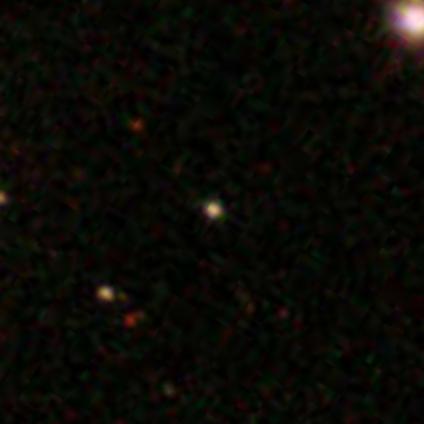
Posted
-
 by
JeanTate
by
JeanTate
AGS00000mt (588011218063851673) object may be the nucleus, but it's not the whole galaxy (petro_r50 - 0.58" - too small, mags too faint, log(mass) too low, etc):
Posted
-
 by
JeanTate
by
JeanTate
AGS000021r (758882025707733014), object is a clump in UGC 2456, not the whole galaxy (petro_r50 - 0.63" - too small, mags too faint, log(mass) too low, etc):
Posted
-
 by
JeanTate
by
JeanTate
AGS0000038 (588848901010686358) object is a clump in UGC 9977, not the whole galaxy (petro_r50 - 0.71" - too small, mags too faint, log(mass) too low, etc):
Posted
-
 by
JeanTate
by
JeanTate
AGS00000to (588295842324021329), object is a clump in NGC 4157, not the whole galaxy (petro_r50 - 0.72" - too small, mags too faint, log(mass) too low, etc):
Posted
-
 by
JeanTate
by
JeanTate
AGS00001w6 (587739811036791074) object is not the whole galaxy, (petro_r50 - 0.76" - too small, mags too faint, etc):
Posted
-
 by
JeanTate
by
JeanTate
AGS00000nz (587729752745902407) object is a clump (giant HII/SF region?), not the whole galaxy (petro_r50 - 0.77" - too small, mags too faint, log(mass) too low, etc):
Posted
-
 by
mlpeck
by
mlpeck
AGS00000an has a highly suspicious looking spectrum blueward of about 6700 A:
Note that the model fit and therefore the continuum estimates are way off in the blue:
http://dr9.sdss3.org/spectrumDetail?plateid=472&mjd=51955&fiber=247
Posted
-
 by
JeanTate
by
JeanTate
There's just one QS-QS duplicate, and it illustrates how some of the outliers came to be in the dataset. The duplicate pair is AGS00000j6 (DR7 ObjId 587731514231619685), and AGS0000080 (587731514231619686). Here are the DR7 images, in the same order:
There are two DR7 spectra, as there must be; all QS (and QC) objects have SDSS spectra, and only DR7 spectra were used in the selection process (i.e. no BOSS spectra). The SpecIds are 117034639469576192 and 117034935805542400; here they are (in the same order):
To the eye they look similar, no?
The line data, from our QS database, are as follows (..j6 first); no errors on any except d4000 (see here for more on why):
- d4000: 1.427±0.043 1.427±0.046
- Halpha: 454 525
- Hbeta: 41.9 57.1
- NaD: 4.22 3.44
- [NII]: 256 226
- [OII]: 70.5 25.8
- [OIII]: 72.3 24.9
Other parameters:
- redshift: 0.047840±0.000007 0.04742±0.00001
- V_disp: 118±15 173±15
- Log_mass: 11.04 10.78
- Petro_R50: 0.75 4.98
- (u, g, r, i, z): (24.7, 23.3, 19.6, 18.4, 17.5) (18.7, 16.8, 15.8, 15.4, 14.7)
As I understand it, the line data is observational, other than a simple model for the continuum, it's just a straight-forward 'count the pixel values' thing. Ditto V_disp.
Redshift is a bit more complicated, but it too is observational; in any case redshifts are hard to get wrong, if there's a good spectrum (i.e. one with a high signal/noise ratio)1.
Log(mass) is derived from the spectrum, but it is heavily, heavily influenced by the (kind of) model used (see the GZ forum thread Estimating the stellar mass of an SDSS galaxy from its colors - how? for more details).
Petro_R50, and the five 'model mags' (one for each band) however, come from the photometric pipeline; in particular, that pipeline includes a 'de-blender', which attempts - automatically - to unscramble overlapping objects, and estimate things like the magnitudes (in each band) and size (Petro_R50, in our case) for each separately. In this case, the de-blender really messed up, big time! Photometrically, AGS0000080 (587731514231619686) is a galaxy; AGS00000j6 (587731514231619685) is not.
1 exception: overlaps, e.g. foreground star and background galaxy, or overlapping galaxies
Posted
-
 by
JeanTate
by
JeanTate
AGS00000wq (587731185657774302) object is an overlap, or clump, or ... in any case, it's not the whole galaxy ((petro_r50 - 0.68" - too small, mags too faint, etc); may explain why log(mass) is -1:
UPDATE: the other object (587731185657774301) is a GALAXY, with a DR7 spectrum. The two redshifts are the same (0.107), so this is not an overlap:
Posted
-
 by
JeanTate
in response to mlpeck's comment.
by
JeanTate
in response to mlpeck's comment.
The spectrum may be quite OK ... just that this is (or contains) a very strange object; maybe a low-z FeLoBAL?
Any chance you could get a typical (hah!) FeLoBAL spectrum, change its redshift to ~0.07, then overlay/add a typical star-forming (or quenched) spectrum?
Posted
-
 by
JeanTate
by
JeanTate
AGS00000ds (154189975032692736) is a strange object; overlap? merger? The yellow blob is the one with a spectrum (two actually; see below); the de-blender had difficulty, and messed up the photometric parameter values (e.g. Petro_R50, band model mags). The pink object is DR7 587728669343613076.
SpecObjID 154191040222330880:
SpecObjID 154189975032692736:
I don't know which of the two spectra was used to derive the spectro-pipeline parameter values in the QS catalog. In any case, it will be interesting to compare them! 😃
Posted
-
 by
mlpeck
in response to JeanTate's comment.
by
mlpeck
in response to JeanTate's comment.
Are you referring to my strange looking blue half of spectrum a few posts up? I'm guessing that's a calibration error, but have no idea how it could have arisen. The emission lines are in the right places.
Posted
-
 by
mlpeck
in response to JeanTate's comment.
by
mlpeck
in response to JeanTate's comment.
Your example a few posts up illustrates the point I made in the duplicates thread. That object has 3 spectra available, and neither of the ones you posted from DR7 are the science primary as of DR9: http://skyserver.sdss3.org/dr9/en/tools/explore/obj.asp?sid=802910431264925696 (link goes to the Object Explorer page for the primary spectrum). Click on the "all spectra" link to see the others.
Posted
-
 by
JeanTate
in response to mlpeck's comment.
by
JeanTate
in response to mlpeck's comment.
Yes, AGS00000an.
What made me think FeLoBAL? This:
Posted by zooite c_cld, in the GZ forum way back in 2011. It's DR8 1237678617437536506. I can't - quickly and easily - check that the various local maxima and minima have approximately the right wavelength relationship, comparing this FeLoBAL with features in the spectrum of AGS00000an. And even if they don't match, FeLoBAL spectra are just weird ...
Posted
-
 by
JeanTate
in response to mlpeck's comment.
by
JeanTate
in response to mlpeck's comment.
Even odder (is there such a word?): the two DR7 spectra have the same (RA, Dec) values; the DR9 one a different (RA, Dec)!
Which one was used, in the PCA-based selection? to calculate log(mass)?
Posted
-
 by
Peter_Dzwig
by
Peter_Dzwig
JT,
I can only see half a spectrum in what you have posted...all of them (as usual Firefox over Windows XP)
Posted
-
 by
JeanTate
in response to Peter Dzwig's comment.
by
JeanTate
in response to Peter Dzwig's comment.
Yeah, there's no way - that I know of - to squish an image, as there is in the GZ forum; at least, not a way that has the blessing of the tech team 😉
I had said, somewhere earlier today, that I'd post links to the spectra (PNG image) as well as the image ... but I haven't lived up to my word 😦 So, I've some serious editing to do; stay tuned ...
Posted
-
 by
JeanTate
by
JeanTate
AGS00000ds (1st image; z=0.158) is yellow and pink; AGS00001eg (588017702403965079, 2nd; z=0.270) is yellow and green! However, AGS00001eg is NOT a Green Pea, as the spectrum clearly shows
(link: http://cas.sdss.org/dr7/en/get/specById.asp?id=478737250604023808)Not so clear that the de-blender had difficulty, and messed up the photometric parameter values (e.g. Petro_R50, band model mags). The yellow object is DR7 588017702403965078.
Posted
-
 by
JeanTate
by
JeanTate
I wrote a post about AGS000018i (DR7 ObjId 588015509820801199) What are the bumps in this spectrum?, but didn't put it in this thread because it simply seemed strange.
Well, V_disp is 850±-3, which makes it an extreme outlier! (Even the most massive of rich cluster, giant ellipticals rarely have velocity dispersions exceeding 350 km/s or so; I wrote about this in the Double trouble? A different kind of overlap GZ forum Object of the Day thread).
Posted
-
 by
JeanTate
by
JeanTate
AGS00000ji (587726878885478661) is a lesser object in a pretty merger (DR9 image). This time the de-blender may have been successful; however, parameters like log(mass) and V_disp may be unreliable, as they are derived assuming a single galaxy (not a piece of galaxy undergoing a major merger).
Posted
-
 by
JeanTate
in response to mlpeck's comment.
by
JeanTate
in response to mlpeck's comment.
Actually, these may be fairly typical of at least some of the post-quenched galaxies! See the What are the bumps in this spectrum? thread for more examples.
Posted
-
 by
c_cld
in response to mlpeck's comment.
by
c_cld
in response to mlpeck's comment.
The SDSS spectrum taken mjd 51955 i.e. 2001-2-15 is that of SN Ia
SN 2001km
Posted
-
 by
mlpeck
by
mlpeck
C_cld: Thanks! That's one mystery solved.
Posted
-
 by
JeanTate
by
JeanTate
AGS000021c (587742062663041028) is a nice merger; however, the de-blender messed up (confused by the glare from the star?), so the value of Petro_R50 is far too large (25.59")
Posted
-
 by
JeanTate
by
JeanTate
AGS00000s1 (587732469848015025) is also a 'nbs' (near bright star) casualty (Petro_R50 22.5"):
Posted
-
 by
JeanTate
by
JeanTate
AGS000017a (588298664111112243) is a clump, not the nucleus (of UGC 7560); it has an unambiguous 'post-quench' spectrum. Perhaps because the (much brighter) nucleus is a different object (with a realistic Petro_R50, 5.27"), the size is wrong (20.44"):
Posted
-
 by
JeanTate
by
JeanTate
AGS00000iz (587731187819937915) is a clump in a very big Eos, UGC 507; maybe that's why Log(mass) is -1?
Posted
-
 by
JeanTate
by
JeanTate
AGS000002i (DR7 ObjId 587722983363117377), Halpha_flux is unphysical (21668100); the spectrum (link) is OK:
Posted
-
 by
JeanTate
by
JeanTate
AGS00001h9 (587738409797419159) also has an erroneous Halpha_flux (4509370); spectrum link:
Posted
-
 by
JeanTate
by
JeanTate
Ditto AGS000022s (587741726574444657), Halpha_flux 10039.3, due to bad spectrum (spectrum link):
Posted
-
 by
JeanTate
by
JeanTate
AGS00000zw (587732772655005756) another bad spectrum, affecting Halpha_flux and Nii_flux (spectrum link):
Posted
-
 by
JeanTate
by
JeanTate
AGS000000e (588848899366977698) bad spectrum, affecting Halpha and Nii fluxes (spectrum link):
Posted
-
 by
JeanTate
by
JeanTate
AGS00000j8 (587730815748866287) has all line fluxes zero; however, the spectrum is OK (link):
Posted
-
 by
JeanTate
by
JeanTate
AGS00000j9 (587726878344741087) also has all line fluxes zero, but the spectrum is OK (link):
Posted
-
 by
JeanTate
by
JeanTate
AGS00001ka (587736543633867051) is a foreground star, with only a few distinct features in the spectrum.
Light from the loose barred spiral is certainly present in the spectrum, given the 3" diameter (radius?) aperture, and as it has strong emission lines, it tends to dominate (to the eye). The DR7 spectrum (link) says "STAR", the DR9 one "GALAXY" (link)
Posted
-
 by
JeanTate
by
JeanTate
AGS00000xe (587731679572852949), bad spectrum (link), though it may not affect things like log_mass:
Posted
-
 by
JeanTate
by
JeanTate
AGS00000wp (587734303806390532) is a first, in terms of classes of outlier.
The spectroscopic and photometric parameter values should (mostly) be OK (mostly? log_mass is -1, V_disp is 0), but the morphology classification is likely to be wrong. 😮
Why?
Because this is an overlap, not an interaction. 😃 First AGS00000wp's spectrum (z=0.024; link), then its companion's (587734303806390531, z=0.117; link):
Posted
-
 by
JeanTate
by
JeanTate
AGS00000v1 (587732701254779013) fluxes are wrong (most/all should be negative); spectrum link:
Posted
-
 by
JeanTate
by
JeanTate
AGS00001zl (587741568197460062) has a strange spectrum. For example, Hbeta is a narrow emission line, in an unmodeled trough; ditto Hgamma (except that it's a stretch to see that it's an emission line). spectrum link (interactive spectrum link, for fine details):
Posted
-
 by
JeanTate
by
JeanTate
AGS000018p (587736920513446352) - the spectrum has no emission lines, so the fluxes in the QS catalog are wrong (spectrum link):
Posted
-
 by
JeanTate
by
JeanTate
AGS000024l (588011216991289534) spectrum is very noisy; (many) emission line fluxes likely wrong (spectrum link; interactive):
Posted
-
 by
JeanTate
by
JeanTate
AGS00000hs (587727178448175195), bad spectrum, and emission line fluxes (mostly) wrong (spectrum link; interactive):
Posted
-
 by
JeanTate
by
JeanTate
AGS000017b (588017111834034306) - spectrum has bad/wrong emission line fluxes (link):
Posted
-
 by
JeanTate
by
JeanTate
AGS00001c1 (588017978908016845) - spectrum has bad/wrong emission line fluxes (link):
Posted
-
 by
JeanTate
by
JeanTate
AGS000009l (587725470131617929) - spectrum has bad/wrong emission line fluxes (link):
Posted
-
 by
JeanTate
by
JeanTate
AGS00001f1 (587736808307294212) - spectrum has bad/wrong emission line fluxes (link):
Posted
-
 by
JeanTate
by
JeanTate
AGS0000161 (588018089475441064) - [OIII] fluxes are wrong (spectrum, interactive):
Posted
-
 by
JeanTate
by
JeanTate
AGS00001gz (587735347489538199) - [OIII] (and Hbeta?) fluxes are wrong (spectrum, interactive):
Posted
-
 by
JeanTate
by
JeanTate
AGS00000sr (587729387684888743) - [OIII] fluxes are wrong (spectrum, interactive):
Posted
-
 by
JeanTate
by
JeanTate
AGS00001xa (587741601491517466) - Halpha, Hbeta fluxes wrong, maybe [OIII] too (spectrum, interactive):
Posted
-
 by
JeanTate
by
JeanTate
AGS0000182 (588015510352298194) is an overlap. This object is a clump in the foreground galaxy, but the spectrum (interactive) is of 588015510352298193. There is a second redshift system in the spectrum, z ~0.0184 (at least NaD, Halpha), that of the foreground galaxy. Might explain why log_mass is -1.
The nucleus of the foreground galaxy is 587731514217398316, and it has a spectroscopic redshift of 0.187 (DR7 spectrum):
GZ forum post on this system here.
Posted
-
 by
JeanTate
by
JeanTate
AGS00002ar (587729227690868785) - Hbeta flux wrong (it's abs, not em); NaD is very strong (spectrum, interactive):
Oh, and log_mass is -1
Posted
-
 by
JeanTate
by
JeanTate
AGS00000y6 (587733604799873167) - Hbeta flux wrong (it's abs, not em); unmarked, very strong, abs line red-ward of Halpha (spectrum, interactive):
Posted
-
 by
JeanTate
by
JeanTate
AGS00000vp (587733080811438163) - Hbeta flux wrong (it's abs, not em); (spectrum, interactive):
Posted
-
 by
JeanTate
by
JeanTate
AGS00002b5 (587729747913605331) - Hbeta flux wrong (it's 'on top of' the brightest sky line), which might account for why log_mass = -1; (spectrum, interactive):
Posted
-
 by
JeanTate
by
JeanTate
AGS00001br (588017724939370680) - [OIII]5007 ("Oiii_flux") flux wrong, impossible task of subtracting skyline; maybe that's why log_mass is -1? (spectrum, interactive):
Posted
-
 by
JeanTate
by
JeanTate
AGS00000j2 (587731513679741093) - bad spectrum, and Hbeta flux is wrong; so log_mass = -1? (spectrum):
Posted
-
 by
JeanTate
by
JeanTate
AGS000018h (587731511538155797) - Oiii flux may be wrong (overlaps strong skyline); may be why log_mass is -1 (spectrum)
Posted
-
 by
JeanTate
by
JeanTate
AGS000007p (587731513691865225) - Hbeta flux estimate may be affected by skyline (spectrum, interactive):
Posted
-
 by
JeanTate
by
JeanTate
AGS00000bs (587726033849155780) - Hbeta flux is wrong (is abs not em), and Oiii flux estimate may be affected by skyline (spectrum, interactive):
Posted
-
 by
JeanTate
by
JeanTate
AGS00001vm (587739406801895648) - Hbeta flux likely wrong, affected by strong skyline (spectrum, interactive):
Posted
-
 by
JeanTate
by
JeanTate
AGS00000wo (587734304344113319) - bad spectrum (spectrum):
Posted
-
 by
JeanTate
by
JeanTate
AGS00002b7 (587739814243991821) - bad spectrum (spectrum):
Posted
-
 by
JeanTate
by
JeanTate
AGS000011u (587734863752986668) - bad spectrum (spectrum):
Posted
-
 by
JeanTate
by
JeanTate
AGS00001xe (587741602030551154) - Oii flux is wrong; it's a strong em line, not an abs one (spectrum, interactive):
Posted
-
 by
JeanTate
by
JeanTate
AGS00000ux (587732578306097298) Oii flux is wrong (and also, likely, V_disp), and there may be a second redshift system (z ~0.137), spectrum, interactive:
Posted
-
 by
JeanTate
by
JeanTate
AGS0000067 (587731187816398960) Oii flux wrong (spectrum):
Posted
-
 by
JeanTate
by
JeanTate
AGS000028h (587742575914582207) Oii flux wrong (spectrum):
Posted
-
 by
JeanTate
by
JeanTate
AGS000026x (587742012747546666) - Hbeta flux wrong (spectrum, interactive):
Posted
-
 by
JeanTate
by
JeanTate
AGS00000j5 (587731511546675396) is a very nice merger, with both objects having z=0.067 spectra (so we can be sure the purple blob - 587731511546675397 - is interacting, not merely a chance projection). However, V_disp is zero.
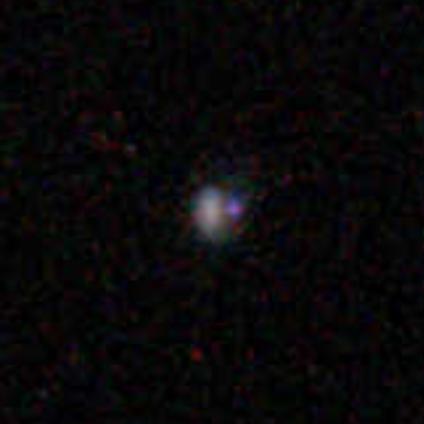
Posted
-
 by
JeanTate
by
JeanTate
AGS00000w5 (587731173844321067) - Hbeta, Oii flux wrong; V_disp likely wrong (330±-50); spectrum, interactive:
Posted
-
 by
JeanTate
by
JeanTate
AGS00000re (587729774220804284) - Oii and Hbeta fluxes wrong (spectrum, interactive):
Posted
-
 by
JeanTate
by
JeanTate
AGS00000tb (588295840706396256) - Oii flux wrong (spectrum):
Posted
-
 by
JeanTate
by
JeanTate
AGS000000w (588848900445241621) - Oii flux wrong (spectrum):
Posted
-
 by
JeanTate
by
JeanTate
AGS00000fs (587728920056037446) - Oii flux wrong (spectrum):
Posted
-
 by
JeanTate
by
JeanTate
AGS000007r (587731512619106324) - Oii flux wrong (spectrum):
Posted
-
 by
JeanTate
by
JeanTate
AGS00000ot (588010879837470816) - Oii flux wrong, bad spectrum (spectrum):
Posted
-
 by
Peter_Dzwig
in response to JeanTate's comment.
by
Peter_Dzwig
in response to JeanTate's comment.
Do I take it that by "outliers" you mean "likely junk" rather than objects at the extremes of some distribution?
Peter
Posted
-
 by
JeanTate
in response to Peter Dzwig's comment.
by
JeanTate
in response to Peter Dzwig's comment.
Not at all!
Certainly an object which is a star - and you'll find several stars in this thread - rather than a galaxy, should not be in any Stage 2 analysis. That's likely true for true overlaps too.
However, for most other outliers, it's not so clear. For example, if a Stage 2 analysis involves only colors and morphology, the fact that the object's spectrum is, um, iffy is irrelevant. On the other hand, if the analysis involves (or requires) fitting a stellar population model, it may fail if there are 'holes' in the spectrum, especially around Halpha.
I've been assuming that the fields (parameters) in the QS catalog are key, and so if the value of any one of those is iffy, then I post it here. Of course, once the flux_Err fields are filled in, finding outliers will be much easier (though outliers in the _Err fields will then need to be identified!).
Perhaps the most interesting outliers are where the spectrum is from a region of the galaxy not centered on the nucleus/bulge: what can we learn, in Stage 2, about overall galaxy properties (to do with being post-quench) from such a spectrum? More generally, what bias might there be if we don't control for fiber covering fraction?
Posted
-
 by
JeanTate
by
JeanTate
I plan to create an "Outliers summary" thread, similar to the Duplicates - summary thread. In it I will group outliers into classes, e.g. 'star', 'bad spectrum'.
Posted
-
 by
mlpeck
by
mlpeck
I think JeanTate's definition of an "outlier" is a little too expansive. I haven't looked at all 11 pages of them, but let's consider the closest one above, object AGS00000ot.
First, the [O II] doublet is right at the blue edge of the SDSS spectroscopy, in fact since the average blue limit is about 3800 Å it will only shift into the observed spectrum for objects with z >~ 0.02. According to Kennicutt (1992 - http://adsabs.harvard.edu/abs/1992ApJ...388..310K) [O II] is useful as a star formation rate indicator if an H alpha flux is unavailable. That's rarely the case in SDSS spectra and I kind of doubt that they will even be used in the final paper.
That said the MPA-JHU estimate of the [O II] flux does appear to be seriously in error, while the SDSS spectro pipeline produced a more reasonable value: http://dr10.sdss3.org/spectrumDetail?plateid=846&mjd=52407&fiber=549.
Second, it's completely normal to have some missing bits of spectra in the SDSS data, which I guess is what prompted the "bad spectrum" label. This isn't a bad spectrum by any stretch. Night sky lines in the red appear to have been adequately subtracted, the model fit on the interactive spectrum page looks good, and reasonably accurate values for velocity dispersion and the more important emission lines appear to have been measured.
As for stellar population model fits, as far as I can tell the stellar mass estimates from Chen et al. (2011) are the only product of SPS models that the science team is currently planning to use and this object isn't one of the ones with a missing mass estimate. In general missing data is part of the game in SPS modelling, and the small bit that's missing here wouldn't have presented a problem.
Posted
-
 by
Peter_Dzwig
in response to JeanTate's comment.
by
Peter_Dzwig
in response to JeanTate's comment.
simple log-mass vs redshift plot will provide a list of outliers in one sense since a number have log-mass zero, but I guess people know that.
Posted
-
 by
JeanTate
in response to JeanTate's comment.
by
JeanTate
in response to JeanTate's comment.
Started: Outliers - summary
It's a WIP (Work In Progress) ...
Posted
-
 by
Peter_Dzwig
in response to JeanTate's comment.
by
Peter_Dzwig
in response to JeanTate's comment.
OK so having got a list of log-mass zero or negative objects where do I upload it to in order to give people a list of questionable targets - and how do I get it out of Tools?
Posted
-
 by
JeanTate
in response to Peter Dzwig's comment.
by
JeanTate
in response to Peter Dzwig's comment.
You used to be able to download tables (etc) in Tools, using a download button (there's a thread on it somewhere), but it no longer works (apparently) 😦
mlpeck has a thread on this topic - Estimating the missing stellar masses - and there are some related posts buried in the Tuesday, August 6th -- Quench Talk Office Hours thread (pages 2 and 3).
My suggestion would be to add to the Estimating the missing stellar masses thread.
Posted
-
 by
mlpeck
by
mlpeck
One more from the control group: AGS00002ds. This also got a thread starting about a month ago: http://quenchtalk.galaxyzoo.org/#/boards/BGS0000003/discussions/DGS000009l.
It turns out this was observed in the BOSS program and a much better S/N spectrum was obtained. BOSS classified it as a z=4.16 QSO:
Compare to the SDSS legacy survey (presumably DR7 or earlier classification):
Posted
-
 by
mlpeck
by
mlpeck
This may not be an outlier, but I'll call attention to it anyway (from the control group): AGS00002cr
The blue pointlike object immediately to the north of the galaxy turns out to be a z=0.71 QSO. That also happens to be the "science primary" spectroscopic object at this position. The galaxy is at redshift z=0.28 and it also has a good, apparently uncontaminated spectrum, but it's not a science primary. See below.
I'm not familiar enough with the SDSS photometry to say if there's an issued with the model magnitudes, etc.
Posted
-
 by
JeanTate
by
JeanTate
There are eight objects classified as "Star or artifact" in QS, and nine in QC.
These have already been posted (as outliers, but not necessarily in this thread); QS first:
AGS00001uo (587739457764393109) - almost certainly a galaxy so small it looks like a star (source)
AGS00002ak (758877274402460510) - truly a star, with a QSO almost on top of it
Next QC:
AGS00002y7 (587732152572313657) - clump, not central object
AGS00002qp (587726014001578079) - overlap
AGS00002x2 (587744874785079427) - a QC-QC duplicate; the other QC object is AGS00003ep, classified as "smooth, completely round, neither":
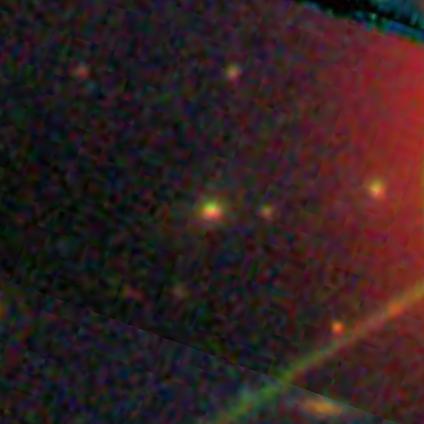
Newly noted - QS:
AGS000005o (587734304342409355)1, AGS0000265 (587742865823825959)1, AGS00000uh (587731172234035209)1:
AGS000026g (588023668100825363)1, 2, AGS00000l1 (587728931871522909)1, AGS000004v (587725505557823574)1
On the last one AGS000004v, kb7wox notes "find the galaxy? it almost lost in the glare of a ~13mag star" (July 20 2013 9:41 PM)
Newly noted - QC:
AGS00003nh (587745539440771084), AGS00003fj (587742551223959798), AGS00003ag (587739115244748811):
AGS00003k3 (587733427088261170), AGS00002ww (587738947208609845), AGS00003hs (587735236882727375)
The last two were discussed in their respective Object threads; on AGS00002ww a note to "always classify the object in the center of the image"; on AGS00003hs:
Odd red stripe across lower right of disc. SDSS spectrum has spike at 6300ang. Artifact or local object (red) superimposed on disc (orange)? ( Spacer fielding)
Red Shift?I am not sure. But personally speaking,I think it's not an artifact. (Foundren Shi)
The DR8 image does contain an artifact (the red streak); here it is in DR7 and DR10:
And the "spike at 6300ang" is an incompletely subtracted sky line, as you can see in the DR7 spectrum:
1 But presumably one of the six mlpeck noted in The objects identified as "stars or artifacts.", "... 6 are clearly galaxies that happen to be close to, and in some cases nearly swamped by the glare from, bright stars. I don't see obvious signs that the spectra are contaminated however."
2 What's the green spot? It's a star, but with "unreliable photometry" (DR10); must add it as an overlap
Posted
-
 by
mlpeck
in response to JeanTate's comment.
by
mlpeck
in response to JeanTate's comment.
Zoom out on AGS00002qp and you'll see this:
which is NGC 4845.
The background object has a secure redshift (z=0.16) and the spectrum looks OK to me, but the photometry is completely wrong.
Posted
-
 by
JeanTate
by
JeanTate
In the thread discussion I started earlier today - Objects - Galaxies? - indistinguishable from point sources - I have details of several other, (some) new, outliers:
AGS00000mt - Petro_R50 ("R50") crazily wrong (QS) (not new)
AGS000021r - ditto, and clump in big local galaxy (not main/center; QS) (not new)
AGS00001eg - star/galaxy overlap? (QS) (not new)
AGS00001fy - R50 wrong (QS)
AGS00000wq - R50 wrong; not main object (QS) (not new)
AGS00002n6 - R50 wrong; not main? (QC)
AGS00004ig - R50 crazily wrong and clump in big local galaxy (not main/center; QC) (not new)
AGS00004ac - overlap? (QC)
AGS00002ud - R50 wrong, not main (QC) (not new)
Posted
-
 by
JeanTate
by
JeanTate
In the Investigating the color outliers thread, several are new outliers (not just for their color):
AGS0000272 - not main object/off-center (QS)
AGS00001bl - spectrum is of a not main object/off-center clump (QS)
AGS0000242 - not main object/off-center (QS)
AGS000029c - not main object/off-center (QS)
AGS000017f - not main object/off-center (QS)
AGS00003yw - spectrum is of a not main object/off-center clump (QC)
Posted
-
 by
zutopian
by
zutopian
I posted a comment about following outlier in another discussion.:
AGS00001rmhttp://quenchtalk.galaxyzoo.org/#/boards/BGS0000003/discussions/DGS0000205
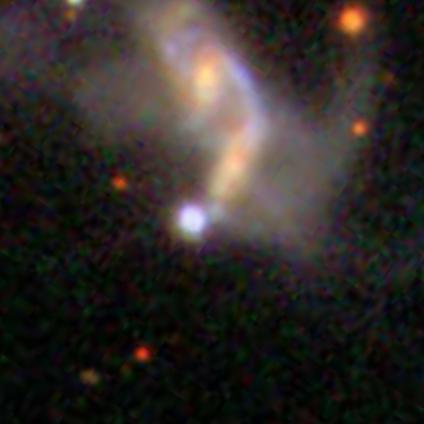
Posted
-
 by
zutopian
by
zutopian
DR7 image is ok: http://cas.sdss.org/dr7/en/tools/explore/obj.asp?id=587742864749101214
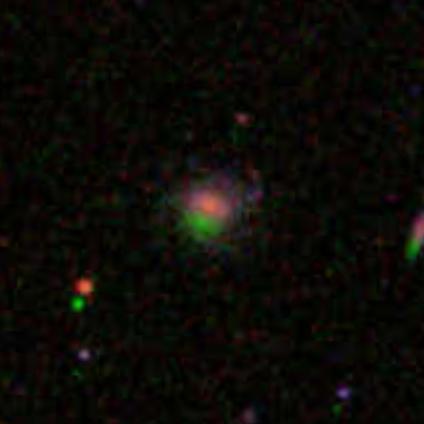
Here is my collection of poorquality images.: http://quenchtalk.galaxyzoo.org/#/collections/CGSS0000cy
Posted
-
 by
JeanTate
by
JeanTate
QC object AGS00003ky (587735695913320628) looks ... almost OK:
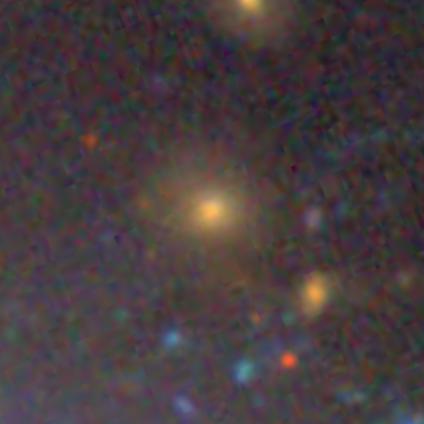
But when you zoom out ...
Yes, that's M101, and when you try 'View on SkyServer', you get "The object corresponding to the id specified, undefined does not exist in the database. Please try another object." Which is DR9's way of telling you that, between DR7 and DR9, the regions around big, bright galaxies were removed from the photometric database (because the photometry is too unreliable1).
I wonder if there's any sign of M101 stars, gas, or dust in the spectrum?
1 I wrote a GZ Object of the Day about this, There's a hole in the sky (several actually)
Posted
-
 by
zutopian
by
zutopian
The link to SDSS doesn't work.:
The object corresponding to the id specified, undefined does not exist in the database.
Please try another object.Posted
-
 by
zutopian
by
zutopian
the link to the sky server data for AGS0000474 is for an object in the next frame to the left
http://quenchtalk.galaxyzoo.org/#/boards/BGS0000002/discussions/DGS00001ph
Posted
-
 by
zutopian
by
zutopian
AGS00000c3 : The spectrum wasn't taken of the nucleus, but from another part of the galaxy.:
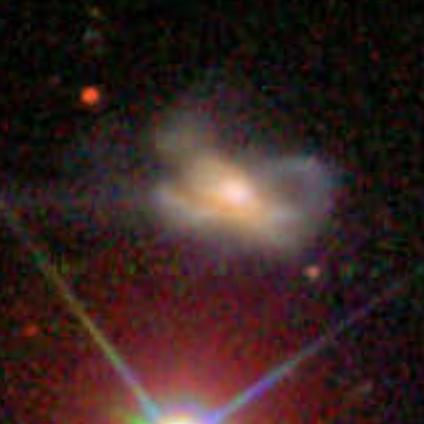
Posted
-
 by
JeanTate
in response to zutopian's comment.
by
JeanTate
in response to zutopian's comment.
AGS000028j : The link to SDSS doesn't work.: The object corresponding to the id specified, undefined does not exist in the database. Please try another object.
That's because it's too close to a very bright star, and so was removed from the database of photometric objects (in DR9):
Posted
-
 by
JeanTate
in response to zutopian's comment.
by
JeanTate
in response to zutopian's comment.
AGS0000474 the link to the sky server data for AGS0000474 is for an object in the next frame to the left http://quenchtalk.galaxyzoo.org/#/boards/BGS0000002/discussions/DGS00001ph
Similar story; the Field in which AGS0000474 is has few (if any) photometric objects (in DR9):
Posted
-
 by
JeanTate
in response to zutopian's comment.
by
JeanTate
in response to zutopian's comment.
Indeed:
Posted
-
 by
zutopian
by
zutopian
AGS000006k QS
Classified as merger. 2 spectra available.: Galaxy and Star.
Below there is the Stripe82 image, which I had posted on the forum a while ago. It looks like a merger and a star overlap.: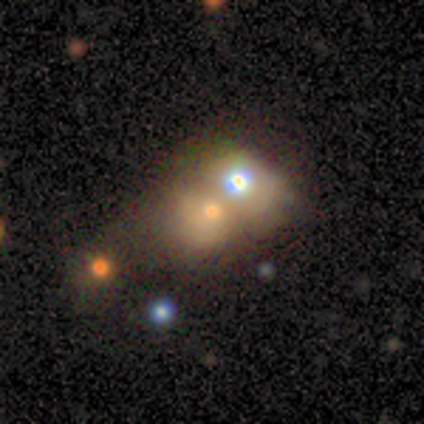
http://zoo3.galaxyzoo.org/examine/AHZ6000f0tForum topic: Star overlapping galaxy?:
http://www.galaxyzooforum.org/index.php?topic=280316.msg618669#msg618669Posted
-
 by
zutopian
by
zutopian
Replaced one of the QC duplicates.:
Posted
-
 by
zutopian
by
zutopian
Replaced one of the QC duplicates.:
Posted
-
 by
zutopian
by
zutopian
Replaced one of the QC duplicates.:
Posted
-
 by
zutopian
by
zutopian
Replaced one of the QC duplicates.:
Posted
-
 by
zutopian
by
zutopian
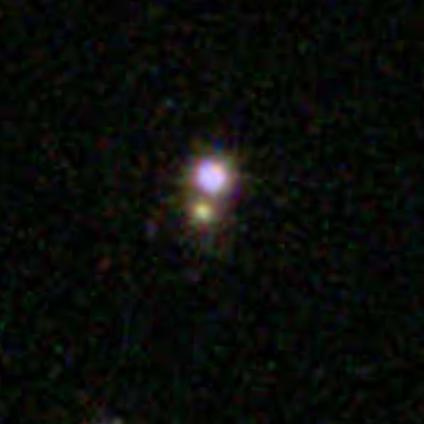
AGS00002as QSPosted
-
 by
zutopian
by
zutopian
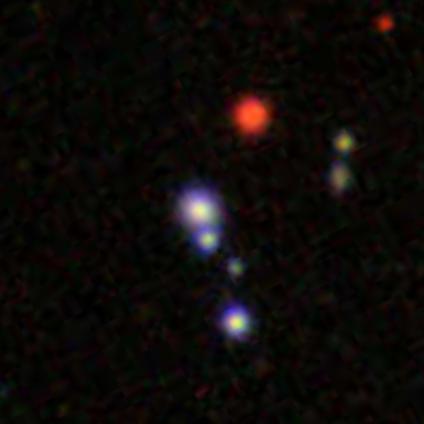
AGS00002b8 QSPosted
-
 by
zutopian
by
zutopian
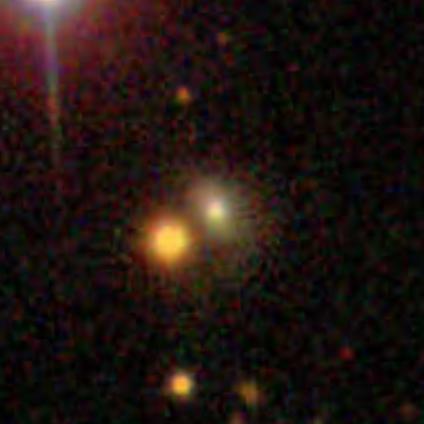
AGS00000f7 QSPosted
-
 by
zutopian
by
zutopian
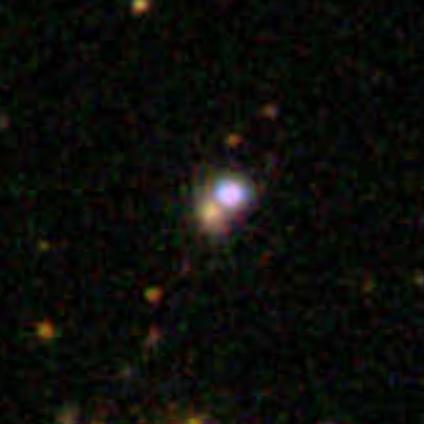
AGS00002e5 QSPosted
-
 by
zutopian
by
zutopian
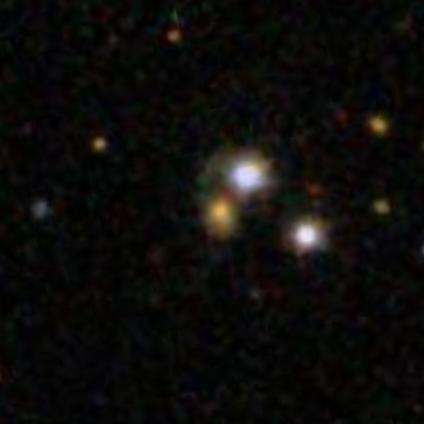
AGS00001g4 QSPosted
-
 by
zutopian
by
zutopian
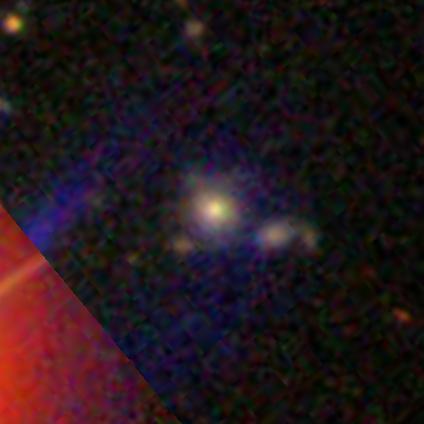
AGS000009p QSPosted
-
 by
zutopian
by
zutopian
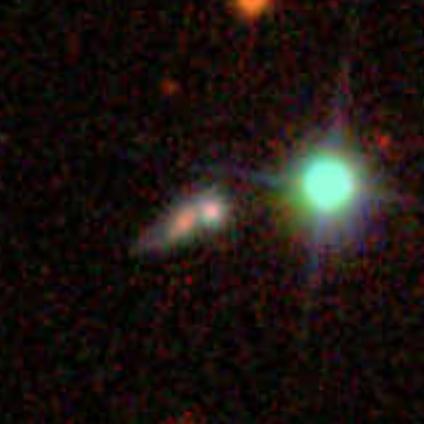
AGS000003c QSContamination by star?
Spectrum: Halpha line is missing.:Posted
-
 by
zutopian
by
zutopian
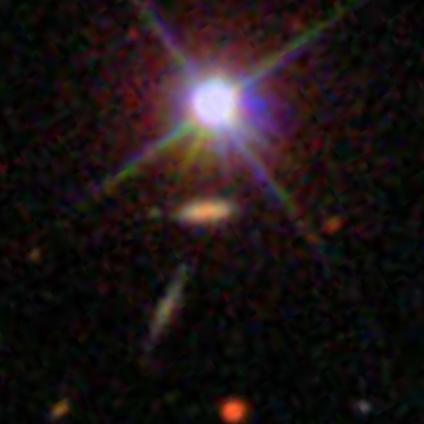
AGS000014z QSPosted
-
 by
zutopian
by
zutopian
Star near to nucleus:
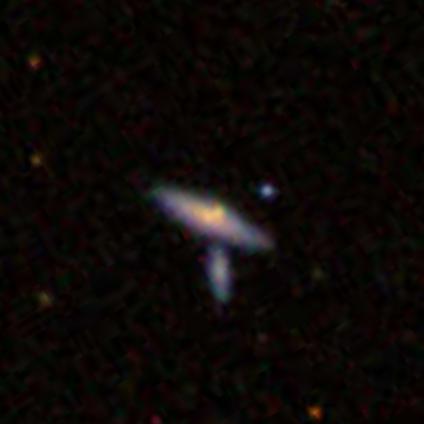
AGS0000153 QSPosted
-
 by
zutopian
by
zutopian
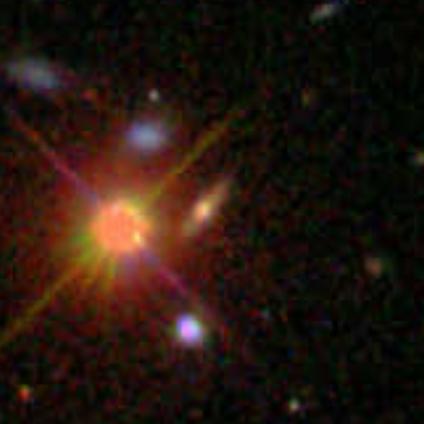
AGS0000186 QSPosted
-
 by
zutopian
by
zutopian
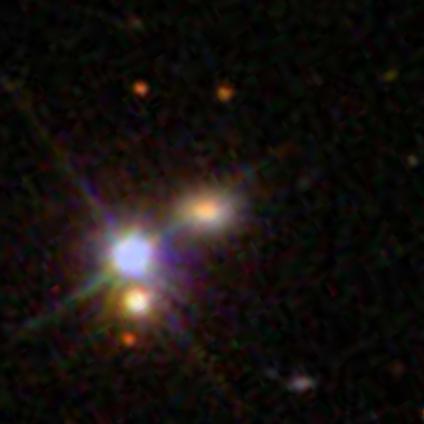
AGS00001c9 QSPosted
-
 by
zutopian
by
zutopian
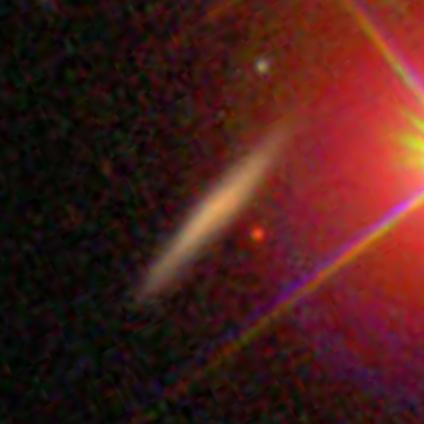
AGS00001mb QSPosted
-
 by
zutopian
by
zutopian
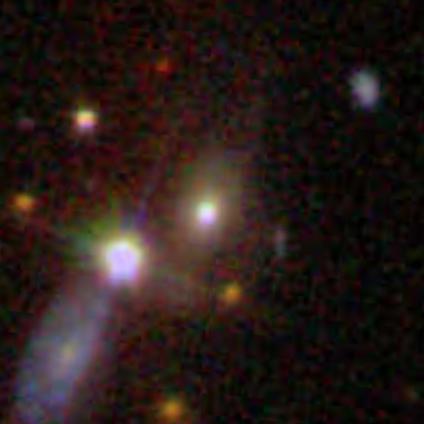
AGS000022l QSPosted
-
 by
zutopian
by
zutopian
Star below nucleus:
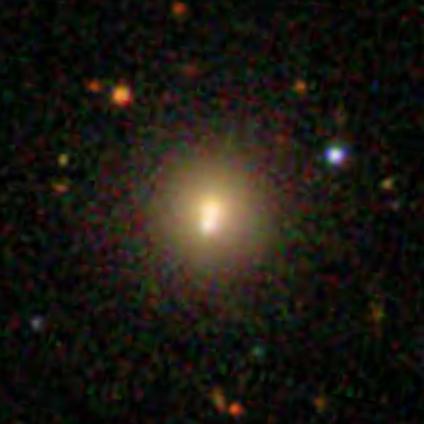
AGS00004h4 QSPosted
-
 by
zutopian
by
zutopian
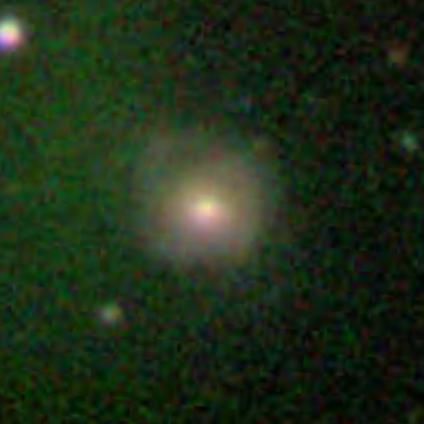
AGS0000126 QSPosted
-
 by
zutopian
by
zutopian
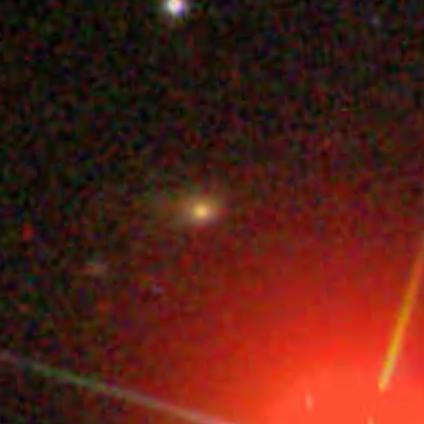
AGS00002aw QSPosted
-
 by
zutopian
by
zutopian
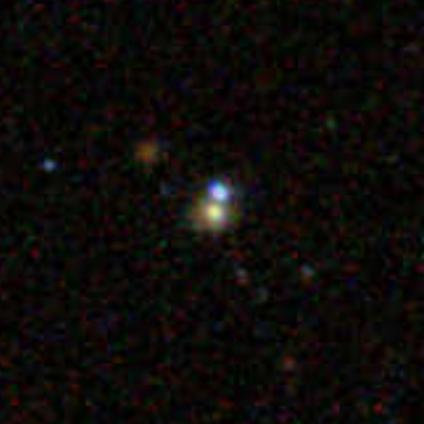
AGS000026a QSStar close to galaxy.
Spectrum is incomplete: H-alpha line is missing.:
http://cas.sdss.org/dr7/en/tools/explore/obj.asp?id=587742575368405057Posted
-
 by
zutopian
by
zutopian
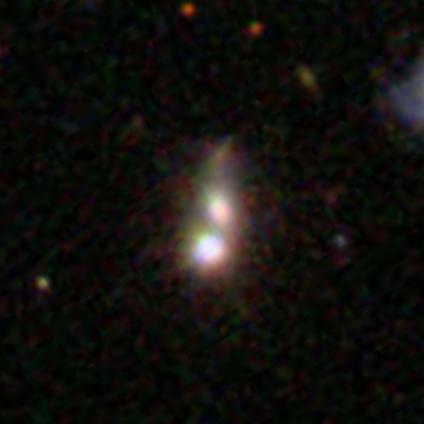
AGS00001mh QSPosted
-
 by
zutopian
by
zutopian
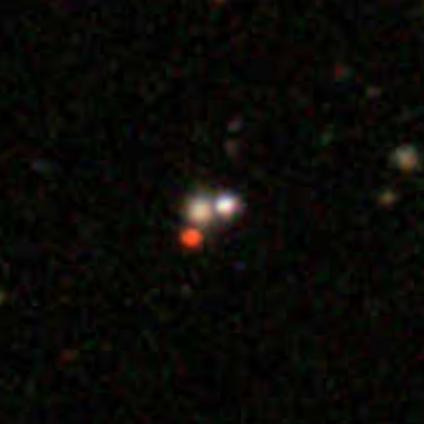
AGS000026s QSPosted
-
 by
zutopian
by
zutopian
contamination by star:
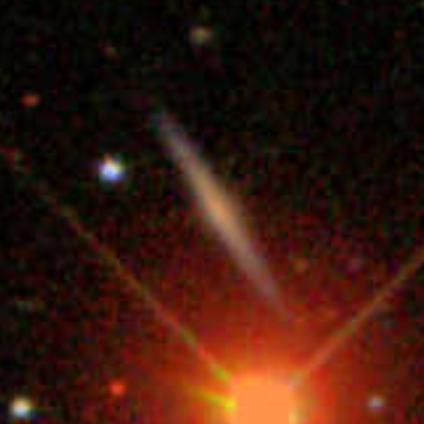
AGS0000044 QS 778Posted
-
 by
zutopian
by
zutopian
contamination by star:
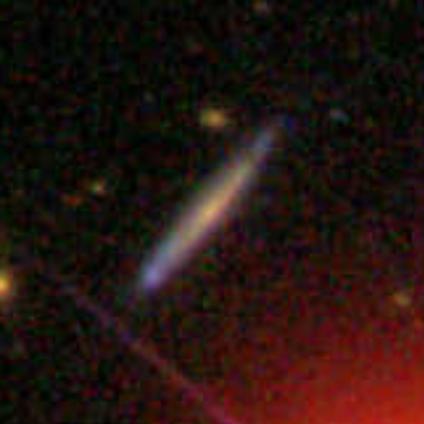
AGS000006v QS 778Posted
-
 by
zutopian
by
zutopian
contamination by star:
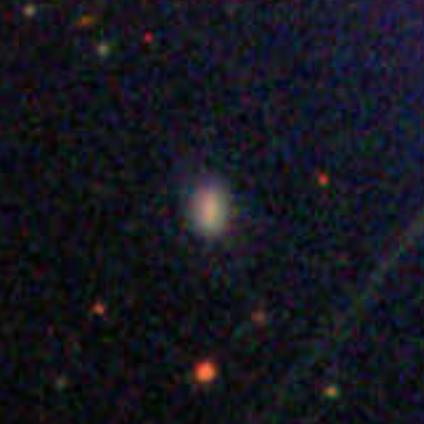
AGS000007f QS 778Posted
-
 by
zutopian
by
zutopian
contamination by star:
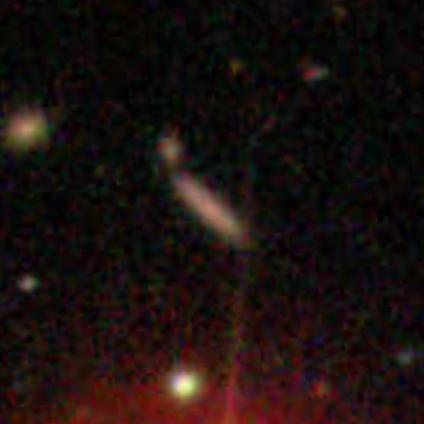
AGS000008x QS 778Posted
-
 by
zutopian
by
zutopian
contamination by star:
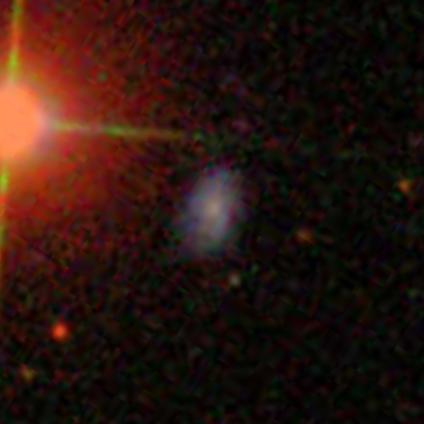
AGS00000b8 QS 778Posted
-
 by
zutopian
by
zutopian
contamination by star:
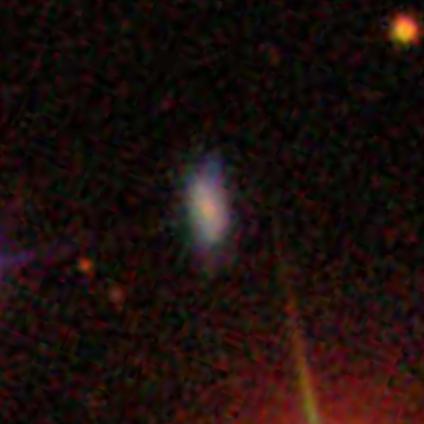
AGS00000e9 QS 778Posted
-
 by
zutopian
by
zutopian
contamination by star:
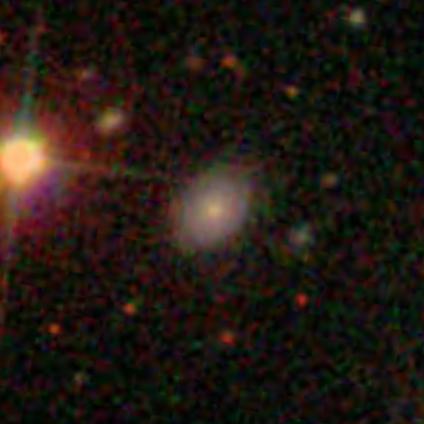
AGS00000js QS 778Posted
-
 by
zutopian
by
zutopian
contamination by star:
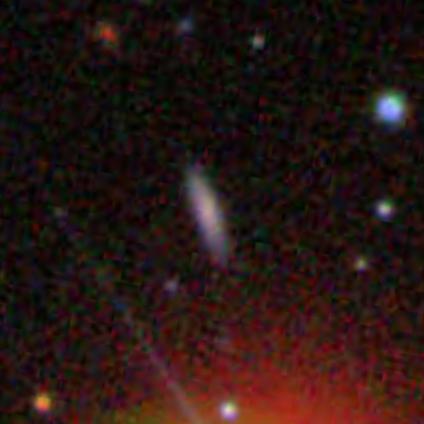
AGS00000jt QS 778Posted
-
 by
zutopian
by
zutopian
contamination by star:
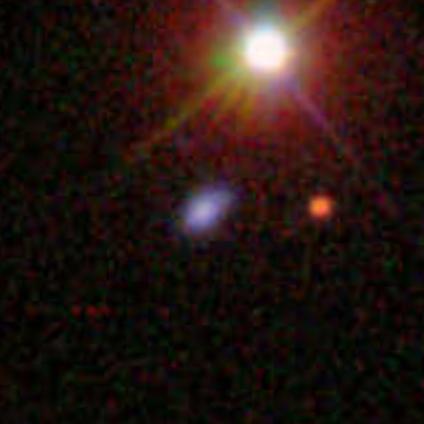
AGS00000rc QS 778Posted
-
 by
zutopian
by
zutopian
contamination by star:
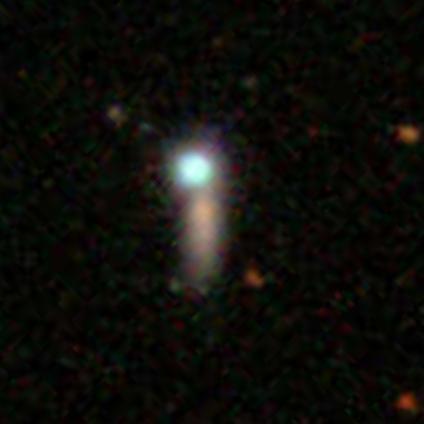
AGS00000xd QS 778Posted
-
 by
zutopian
by
zutopian
contamination by star: Navigate to see.:
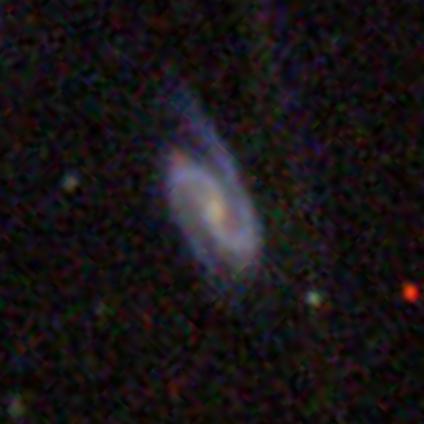
AGS00000gf QS 778Posted
-
 by
zutopian
by
zutopian
contamination by star:
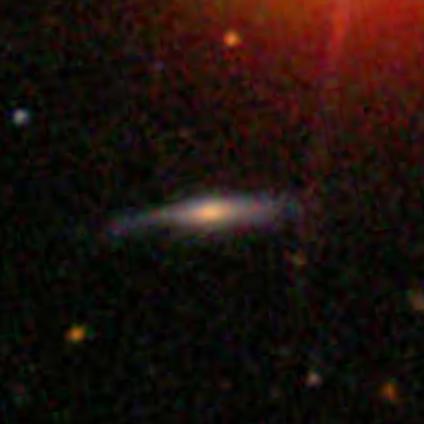
AGS00001f7 QS 778Posted
-
 by
zutopian
by
zutopian
contamination by star:
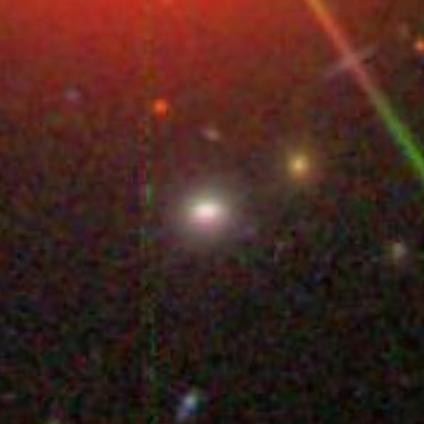
AGS00001j3 QS 778Posted
-
 by
zutopian
by
zutopian
contamination by star:
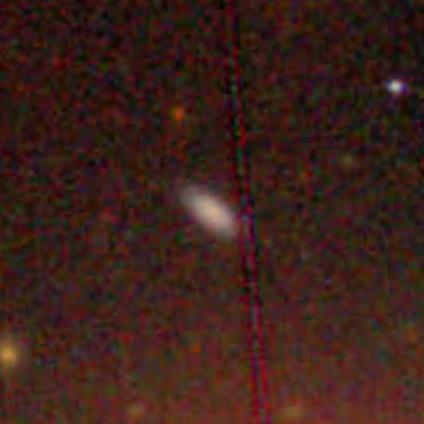
AGS00001l4 QS 778Posted
-
 by
zutopian
by
zutopian
contamination by star:
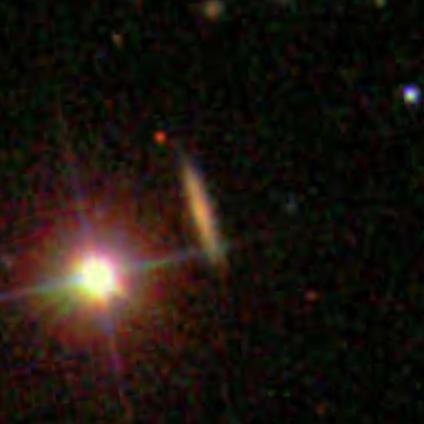
AGS00001la QS 778Posted
-
 by
zutopian
by
zutopian
contamination by star:
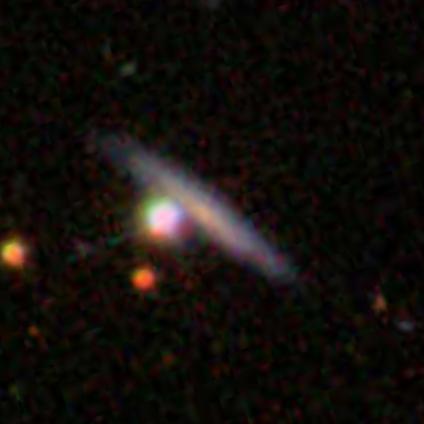
AGS00001uc QS 778Posted
-
 by
zutopian
by
zutopian
contamination by star: Navigate to see.:
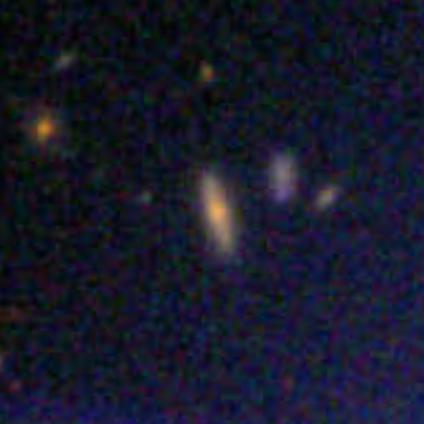
AGS000026p QS 778Posted
-
 by
zutopian
by
zutopian
contamination by star:
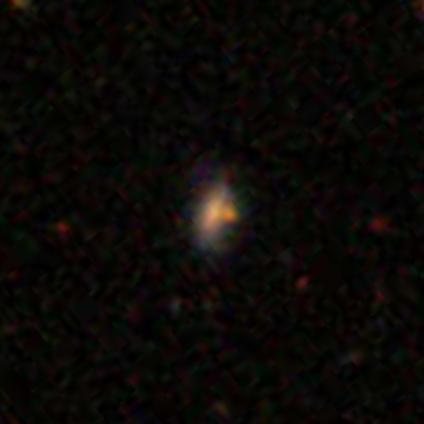
AGS00000dk QS 778Posted
-
 by
zutopian
by
zutopian
contamination by star:
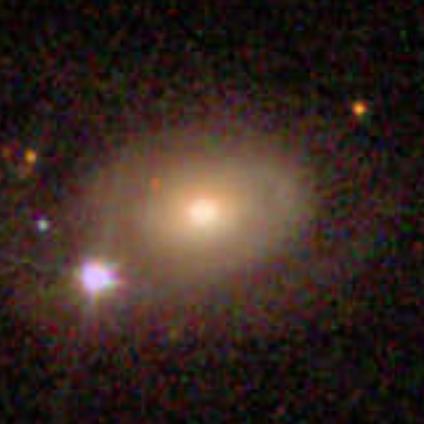
AGS000005g QS 778Posted
-
 by
zutopian
by
zutopian
contamination by star:
AGS00001hr QS 778Posted
-
 by
zutopian
by
zutopian
QS 778 sample: Further cases, where maybe contamination by star.:
AGS000029w
AGS000009f
AGS00000gg
AGS00000hn
AGS00000jq
AGS00001c8
AGS00001ry
AGS00001xi
AGS0000212
AGS00002ab
AGS000008i
AGS00000d6
AGS00001it
AGS00001kg
AGS00001sf
AGS00000cz star has a spectrum
AGS00000ym
AGS00001x1
AGS00001x5
AGS00000yn
AGS00000zu
AGS00001mx
AGS00001w3
AGS000003j
AGS00000gs
AGS00000x6
AGS0000198
AGS000015m
AGS00000ag
AGS000008t
AGS00000zi
AGS00000uq
AGS00001dz
AGS00001g0
AGS000020f
AGS0000294
AGS000020v
AGS000028a
AGS00000lu
AGS000007c
AGS00000iu
AGS00001vw
AGS000025u
AGS000026b
AGS00001q9Posted
-
 by
zutopian
by
zutopian
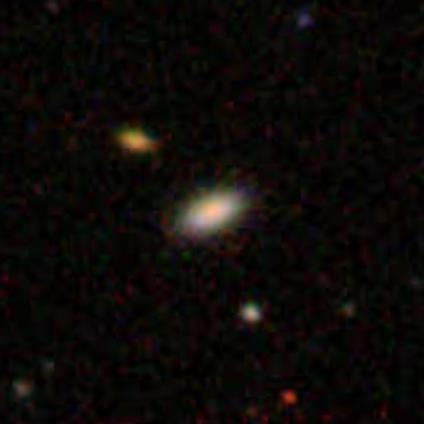
AGS000014f QS 778H-alpha line missing:
Posted
-
 by
zutopian
by
zutopian
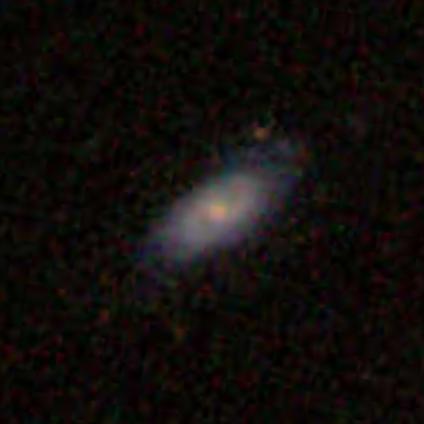
AGS0000226 QS 778H-alpha line is missing.:
Posted
-
 by
zutopian
by
zutopian
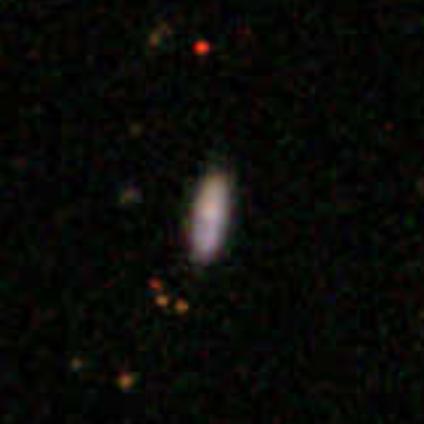
AGS00002j8 QC 778Spectrum is incomplete.:
Posted
-
 by
zutopian
by
zutopian
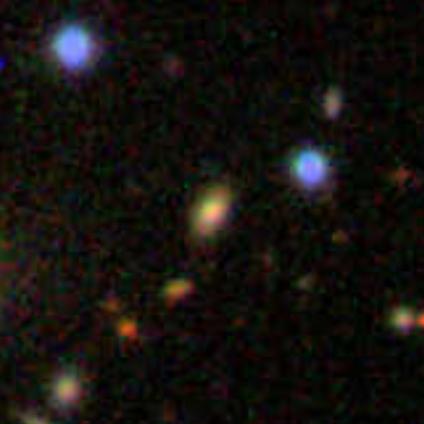
AGS000040k QC 778Halpha line is missing.:
Posted
-
 by
zutopian
by
zutopian
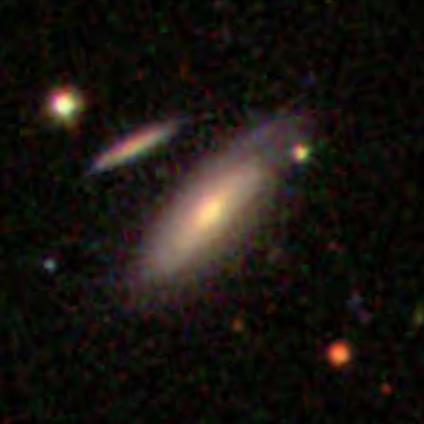
AGS000044x QC 778Halpha line is missing.:
Posted
